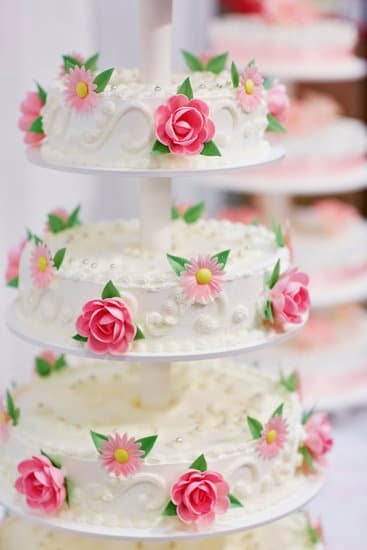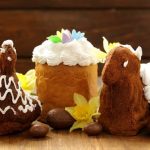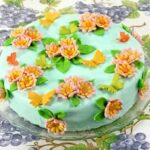Edible cake decorations are the icing on the cake when it comes to making any confection truly special. They add a touch of beauty, creativity, and whimsy that can take a simple cake from ordinary to extraordinary. In this article, we will explore the world of edible cake decorations and uncover what they are made of, how they enhance the overall aesthetic appeal of a cake, and why they have become increasingly popular among bakers and consumers alike.
Cake decorations play a vital role in elevating the visual appeal of any cake. From intricate designs to delicate details, these edible adornments have the power to transform a plain dessert into a work of art. Whether it’s a birthday cake or a wedding masterpiece, using edible decorations allows for endless creative possibilities that capture everyone’s attention.
With an increasing emphasis on personalization and uniqueness, edible cake decorations have seen a surge in popularity in recent years. Bakers and home enthusiasts are discovering that these charming embellishments not only enhance the beauty of their creations but also allow them to showcase their own skills and imagination. The demand for edible decorations has given rise to countless options in the market with various types and styles readily available.
In the following sections, we will delve into the world of edible cake decorations, exploring different types such as fondant, gum paste, and royal icing. We will discover how each type is made, its specific characteristics, and how it can be used to create stunning designs.
Additionally, we will unveil the secrets behind their ingredients and discuss why using certified brands is essential for ensuring both safety and quality. So let’s embark on this delicious journey together as we unravel what exactly edible cake decorations are made of.
Understanding Edible Cake Decorations
Introduction: Why Edible Cake Decorations Are the Perfect Finishing Touch
Decorating a cake is an essential step in creating a visually appealing and enticing dessert. Edible cake decorations take this art form to a whole new level, offering a range of options to transform an ordinary cake into a delicious masterpiece. These decorations come in various forms, each with its own unique qualities and uses. In this section, we will explore the different types of edible cake decorations available in the market and their creative potential.
Fondant: Creating Intricate Designs
One of the most popular types of edible cake decorations is fondant. Made from sugar, water, and glucose syrup, fondant has a dough-like consistency that can be easily rolled out and draped over cakes. Fondant provides a smooth and flawless canvas for intricate designs, allowing bakers to create stunning visual effects on their cakes.
It can be shaped into delicate flowers, sculpted figures, or even used as a base for painted designs. The versatility of fondant makes it an ideal choice for special occasions like weddings or birthdays.
Gum Paste: Detailed and Lifelike Decorations
While fondant is great for large-scale designs, gum paste is commonly used for smaller, more detailed decorations. Unlike fondant, gum paste contains added ingredients like egg whites or gelatin, which give it a pliable texture that dries hard.
This characteristic allows gum paste to hold its shape when molded into intricate objects such as leaves, petals, or delicate lace patterns. With gum paste, bakers can create lifelike flowers with realistic color gradients and textures that add depth and dimension to their cakes.
Royal Icing: Versatile Piping Designs
Another type of edible cake decoration worth exploring is royal icing. Made from egg whites and powdered sugar beaten to stiff peaks, royal icing has a smooth consistency that can be piped onto cakes using various tips to create intricate patterns and designs. Royal icing can be used to make delicate lacework, intricate borders, or detailed sculptures.
Its versatility allows for both traditional and modern designs, making it a popular choice among decorators. Royal icing also dries hard, giving it stability and allowing for easy transportation and storage.
Understanding the different types of edible cake decorations is essential in choosing the right one for your creation. Each type offers its own advantages and artistic possibilities, allowing bakers to bring their creativity to life. Whether you prefer the smooth canvas of fondant, the detailed intricacy of gum paste, or the versatility of royal icing, these edible decorations will undoubtedly elevate the look of any cake.
Ingredients Used in Edible Cake Decorations
Edible cake decorations are not only visually appealing but also delicious. However, have you ever wondered what these decorations are made of? It’s time to unveil the secrets behind the ingredients used in edible cake decorations and how they contribute to the durability, taste, and appearance of these delectable creations.
One of the most common ingredients used in edible cake decorations is sugar. Sugar serves as a binding agent and provides the desired sweetness to the decorations. It also helps to create a smooth texture and gives the decorations a longer shelf life. Cornstarch is another key ingredient that is often used. It acts as a thickening agent and helps to give stability to the decoration, preventing it from sagging or losing its shape.
Gelatin is another essential ingredient found in many edible cake decorations. It helps to provide structure and firmness, making it easier to work with intricate designs or three-dimensional shapes. Gelatin also adds elasticity, allowing for flexibility when handling delicate decorative elements.
Glucose is another important component commonly included in edible cake decorations. It acts as a humectant, which means it retains moisture, ensuring that the decoration stays soft and pliable for an extended period of time. Glucose also enhances shine and provides a glossy finish to the decorations.
Lastly, food coloring plays a crucial role in making edible cake decorations vibrant and eye-catching. When creating edible decorations, both natural and artificial food coloring can be used to achieve various shades and hues.
Understanding these key ingredients allows bakers and decorators to make informed choices when selecting or making their own edible cake decorations. By knowing what goes into these delightful creations, you can ensure that your cakes are not just visually stunning but also deliciously enjoyable.
| Ingredient | Function |
|---|---|
| Sugar | Binding agent, sweetness, texture |
| Cornstarch | Thickening agent, stability |
| Gelatin | Structure, firmness, elasticity |
| Glucose | Humectant, moisture retention, shine |
| Food coloring | Vibrant colors and shades |
Safety and Certification
When it comes to selecting edible cake decorations, safety should always be a top priority. Ensuring that the decorations are safe for consumption not only protects your health but also gives you peace of mind when serving them to others. In this section, we will emphasize the importance of using certified edible cake decorations, explain the certification processes and standards, and provide guidance on identifying reliable and safe brands.
The Importance of Certified Edible Cake Decorations
Certification is crucial when it comes to edible cake decorations as it guarantees that the products have met specific safety criteria set by regulatory authorities. Certified decorations undergo rigorous testing to ensure that they are free from harmful substances and contaminants. This includes checking for allergens, heavy metals, and other potentially hazardous ingredients.
Using uncertified edible cake decorations can pose risks such as allergic reactions or contamination. Consumers should always look for certifications or seals of approval from reputable organizations like the Food and Drug Administration (FDA) or other local food safety agencies.
Understanding Certification Processes and Standards
The certification processes and standards vary depending on the country or region. For example, in the United States, the FDA regulates food packaging materials, which include edible decorations. They have guidelines in place to ensure that these products are safe for consumption.
In addition to federal regulations, some states may have their own certification requirements for edible products. It’s essential to familiarize yourself with these regulations if you plan on producing and selling homemade edible cake decorations.
When purchasing ready-made edible cake decorations, look for certifications such as “FDA Approved” or any other relevant certificates issued by recognized food safety organizations in your area.
Identifying Reliable and Safe Brands
Finding reliable and safe brands can be challenging with so many options available in the market. One way to identify trustworthy brands is by doing research and reading customer reviews. Look for brands that prioritize safety and quality in their product descriptions and packaging.
You can also seek recommendations from professional bakers or cake decorating communities. Experienced individuals often have valuable insights and can guide you towards reputable brands that consistently produce safe edible decorations.
DIY Option
Making edible cake decorations at home is a cost-effective and personalized option that allows you to showcase your creativity. Whether you are a seasoned baker or just starting out, creating your own edible cake decorations can add a special touch to any celebration.
To begin, there are several basic decorations that you can easily make at home. Fondant cut-outs are a popular choice and can be created by rolling out fondant and using cookie cutters to create shapes. Modeling chocolate figures are also a fun option, as they can be molded into various shapes and sizes. Additionally, piped designs using buttercream or royal icing can add intricate details to your cake.
When making your own edible cake decorations, it is important to have the right tools and ingredients. Some essential tools include rolling pins, piping bags with tips, cookie cutters, and molds. As for ingredients, you will need items such as fondant or gum paste for shaping and sculpting, food coloring for adding vibrant hues, and powdered sugar or cornstarch for dusting surfaces while working with fondant or gum paste.
To achieve professional-looking results, it is helpful to follow step-by-step instructions and practice different techniques. There are many online resources available that provide detailed tutorials and guides on creating various edible cake decorations. Don’t be afraid to experiment with different techniques and designs to find your own unique style.
By making your own edible cake decorations at home, not only will you have complete control over the design and customization of your cakes but also save money in the process. So next time you have a special occasion coming up, consider trying your hand at DIY edible cake decorations for an extra special touch that will impress both visually and in taste.
Specialty Edible Decorations
As the world of cake decorating continues to evolve, specialty edible decorations have become increasingly popular among bakers and cake enthusiasts. These unique and innovative options offer endless creative possibilities, allowing individuals to add a personalized touch to their cakes.
One example of specialty edible decorations is printed wafer paper. This thin, edible paper can be customized with designs or patterns using edible ink. It can then be used to create beautiful accents or even entire cake wraps. Printed wafer paper is a versatile option that allows for intricate detailing and vibrant colors.
Another exciting option is edible images. With advancements in technology, it is now possible to print high-resolution images onto edible sheets using food-safe inks. These images can then be applied directly onto cakes, adding a personalized touch or showcasing logos or photographs. Edible images are an excellent choice for birthdays, anniversaries, and corporate events.
For those looking to make a statement with their cakes, 3D-printed sugar sculptures are becoming increasingly popular. Using specialized 3D printers that work with sugar paste, intricate and lifelike designs can be created to adorn cakes. From floral arrangements to figurines, these specialty decorations truly elevate the artistic aspect of cake decorating.
Customizable options for special occasions are also widely available among specialty edible decorations. Whether you’re celebrating a wedding, baby shower, or holiday event, there are countless themed decorations to choose from. From delicate sugar flowers for weddings to adorable baby-themed fondant cut-outs, these decorations ensure every celebration is one-of-a-kind.
Overall, specialty edible decorations provide an avenue for creativity and personalization when it comes to cake decorating. With options like printed wafer paper, edible images, 3D-printed sugar sculptures, and customizable designs for special occasions readily available in the market today; your imagination is the only limit when it comes to creating stunning and unique cake designs.
Flavor in Focus
Edible cake decorations not only add beauty and creativity to a cake, but they also play an important role in enhancing its flavor. The right combination of flavors can elevate a simple cake into a culinary masterpiece. In this section, we will explore how edible cake decorations contribute to taste and provide ideas for pairing decorations with specific cake flavors.
When it comes to adding flavor to edible cake decorations, the options are endless. Popular flavors used in decorations include vanilla, chocolate, fruit extracts, and buttercream. These flavors can be incorporated into fondant, gum paste, or royal icing to create delicious and visually appealing decorations.
Vanilla is a classic flavor that pairs well with almost any type of cake. It adds a subtle sweetness and enhances the overall taste. Chocolate-flavored edible decorations are perfect for chocolate cakes or as accents on other flavors such as vanilla or red velvet.
Fruit extracts like strawberry, lemon, or raspberry can add a burst of freshness and tanginess to both the decoration and the cake itself. Imagine a lemon-flavored fondant bow on top of a lemon cake – it creates a cohesive taste experience that delights the palate.
Buttercream is not just for frosting. It can also be used as a base for creating soft and creamy edible decorations. Buttercream flowers or piped designs made from buttercream add richness and depth to any cake flavor.
To create harmonious flavor combinations, consider matching the flavors in your edible decorations with the flavors in your cake batter or fillings. For example, if you’re making a strawberry-flavored cake with cream cheese filling, consider using strawberry-flavored fondant roses as decoration.
| Edible Decoration | Common Flavors |
|---|---|
| Fondant | Vanilla, Chocolate, Fruit Extracts, Buttercream |
| Gum Paste | Vanilla, Chocolate, Fruit Extracts, Buttercream |
| Royal Icing | Vanilla, Fruit Extracts |
Avoiding Common Pitfalls
Working with edible cake decorations can be a fun and rewarding experience, but it’s not without its challenges. In this section, we will provide you with some valuable tips and tricks to help you avoid common pitfalls while working with edible cake decorations.
One common issue that many people face when working with edible cake decorations is sticking. Fondant or gum paste decorations have a tendency to stick to the surface they are placed on, making them difficult to handle. To prevent sticking, it is important to lightly dust your work surface and tools with cornstarch or powdered sugar before working with the decorations. This will create a barrier between the decorations and the surface, allowing for easy handling and manipulation.
Another potential problem is cracking or drying out of edible cake decorations. These delicate decorations can easily dry out if not properly stored or handled. To prevent cracking, it is essential to keep the decorations covered when not in use.
Wrapping them tightly in plastic wrap or storing them in an airtight container will help retain their moisture and prevent them from drying out. Additionally, if you notice that your fondant or gum paste decorations are starting to crack while working with them, you can apply a small amount of vegetable shortening or edible glue to smooth out any imperfections.
Proper storage and handling of edible cake decorations are crucial for maintaining their longevity. It is recommended to store them in a cool, dry place away from direct sunlight. Extreme temperatures and humidity can cause the decorations to melt or become discolored. Furthermore, when transporting cakes adorned with edible decorations, it’s important to take precautions such as using proper support structures and careful handling to ensure that the decorations remain intact.
To make your experience working with edible cake decorations easier and more efficient, there are several resources and tools available in the market. Investing in quality tools like silicone molds, cutters, and brushes specifically designed for decorating cakes can greatly enhance your results.
Additionally, there are numerous online tutorials and instructional videos that offer step-by-step guidance on working with different types of edible decorations. These resources can provide valuable tips and techniques to help you achieve professional-looking results.
By keeping these tips in mind, you’ll be able to avoid common pitfalls while working with edible cake decorations. With practice and patience, you’ll become more proficient in creating beautiful and intricate designs that will impress your friends and family at your next celebration. So go ahead, unleash your creativity, and enjoy the process of decorating your cakes with delicious edible decorations.
Conclusion
In conclusion, choosing the perfect edible cake decorations for your next celebration can truly elevate the overall aesthetic appeal of your cake. Throughout this article, we have explored the different types of edible cake decorations available in the market, discussed their ingredients and safety considerations, delved into DIY options, and even explored specialty edible decorations. By considering these factors, you can create a beautifully decorated cake that not only looks amazing but also tastes delicious.
It is important to remember that there are endless possibilities when it comes to edible cake decorations. Whether you choose fondant, gum paste, royal icing, or even explore printed wafer paper or 3D-printed sugar sculptures, the key is to let your creativity shine through. Don’t be afraid to experiment with different techniques and designs to find what works best for your vision.
When selecting edible cake decorations, it is crucial to ensure their safety and quality. Look for certified brands that adhere to strict standards and certification processes. This will give you peace of mind knowing that the decorations are safe for consumption.
Lastly, if you are unsure about creating your own edible cake decorations, there are many resources and online stores where you can purchase high-quality products. These resources often provide additional tips and ideas on how to use their products effectively.
So go ahead and dive into the world of edible cake decorations. Let your imagination run wild as you create stunning designs that will leave everyone in awe at your next celebration.
Frequently Asked Questions
What are edible cake images made from?
Edible cake images are made from a thin layer of icing or frosting that has been printed with food-safe ink. This printing process allows for high-resolution images or designs to be transferred onto the edible sheet, creating a custom decoration for cakes.
The icing sheet is typically made from sugar and cornstarch, making it safe for consumption while still maintaining the durability needed to hold the image without tearing or melting.
What are cake decorations made of?
Cake decorations can be made from a variety of materials, depending on the desired design and theme. Common materials used for cake decorations include fondant, gum paste, marzipan, chocolate, and royal icing. Fondant is a pliable icing made primarily from sugar and water that can be shaped into different forms such as flowers, bows, or ribbons. Gum paste has similar ingredients to fondant but has added gum tragacanth or tylose powder which gives it more strength and allows for finer details in sculpting intricate pieces like figurines or lace patterns.
Marzipan is an almond-based sweet paste often used for molding small shapes or covering cakes. Chocolate decorations can be crafted by melting chocolate and shaping it into various forms like curls, flowers, or decorative accents. Royal icing is made from powdered sugar and egg whites which hardens when dried, making it ideal for piping intricate designs onto cakes.
What are edible toppers made of?
Edible toppers are typically made of similar materials as cake decorations since they serve as decorative elements on top of cakes. Fondant is a commonly used material as it can be rolled out and cut into different shapes like circles or squares to create edible toppers that match the theme of the occasion.
Sometimes these toppers are also handcrafted using techniques like sculpting with gum paste or modeling chocolate to create more intricate designs such as personalized figures or themed characters. Overall, edible toppers offer a fun way to customize cakes with eye-catching elements that can be enjoyed along with the rest of the cake.

Welcome to our cake decorating blog! My name is Destiny Flores, and I am the proud owner of a cake decorating business named Cake Karma. Our mission is to provide delicious, beautiful cakes for all occasions. We specialize in creating custom cakes that are tailored specifically to each customer’s individual needs and tastes.





